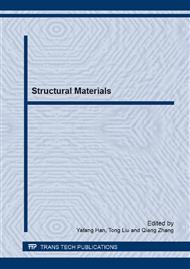p.498
p.504
p.511
p.519
p.525
p.531
p.538
p.543
p.549
Effects of High Temperature Treatments on PPB’s in a P/M Superalloy
Abstract:
FGH96 components of aircraft engines were produced by a processing route of hot isostatic pressing plus heat treatment (as-HIP). The prior particle boundaries (PPB’s) could be found in those articles in spite of the lower carbon content in the alloy. Attempts to eliminate or reduce PPB’s in as-HIP FGH96 alloy have been carried out by either increasing the HIP temperature from 1180oC to 1230oC or taking an appended annealing treatment at 1230oC. Based on experimental results, a thermodynamic analysis by using Jmat Pro has been conducted to understand the effects of high temperature treatments on PPB’s in FGH96 alloy. PPB’s found in as-HIP FGH96 alloy were mainly constituted by MC carbides enriched in Ti and Nb. The results of a thermodynamic analysis presented that carbides precipitated on TiN nucleus and grew up to form PPB’s. High temperature treatments, both increasing HIP temperature and taking a high temperature annealing treatment after HIP, could reduce the equilibrium amount of MC carbides and the surface segregation of Ti in powder particles, and turned the continuous precipitates into broken particles on PPB’s. Although the PPB’s could not be completely eliminated by high temperature treatments, an obvious improvement in rupture life of the material could be observed.
Info:
Periodical:
Pages:
525-530
Citation:
Online since:
April 2014
Authors:
Keywords:
Price:
Сopyright:
© 2014 Trans Tech Publications Ltd. All Rights Reserved
Share:
Citation:


